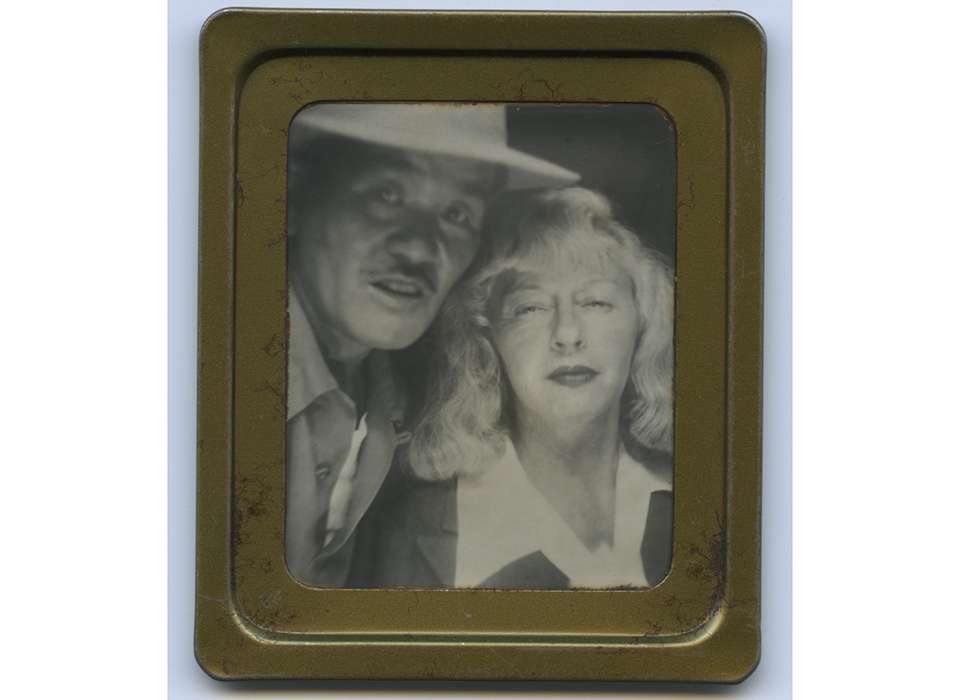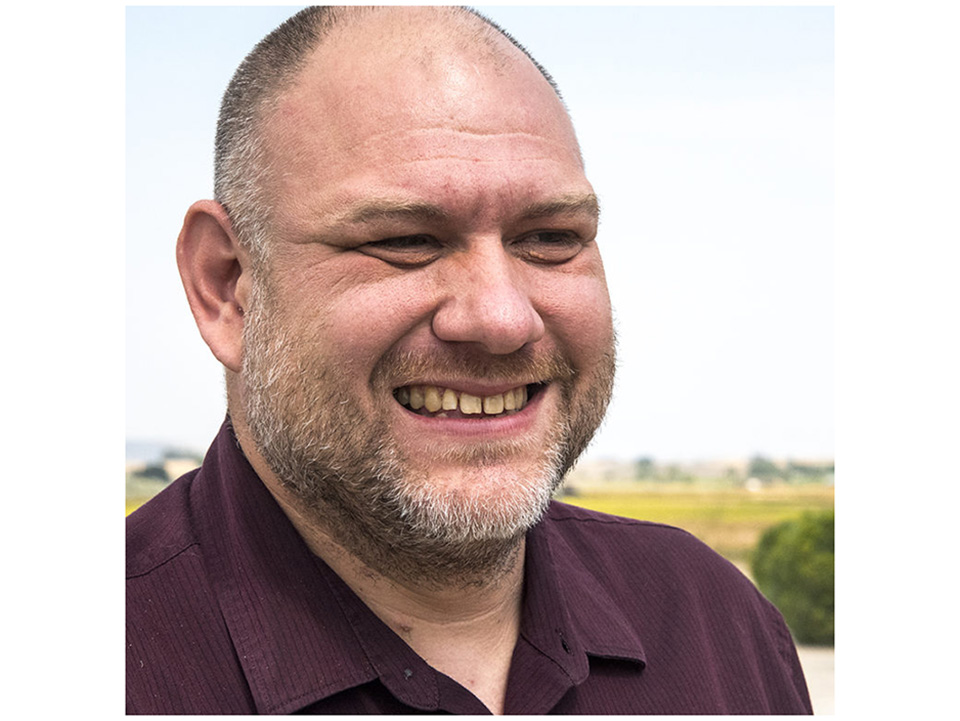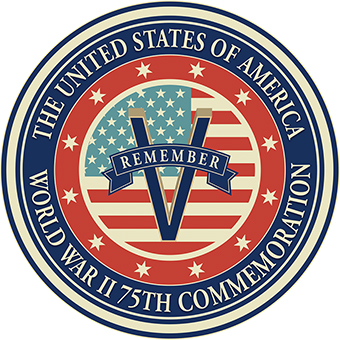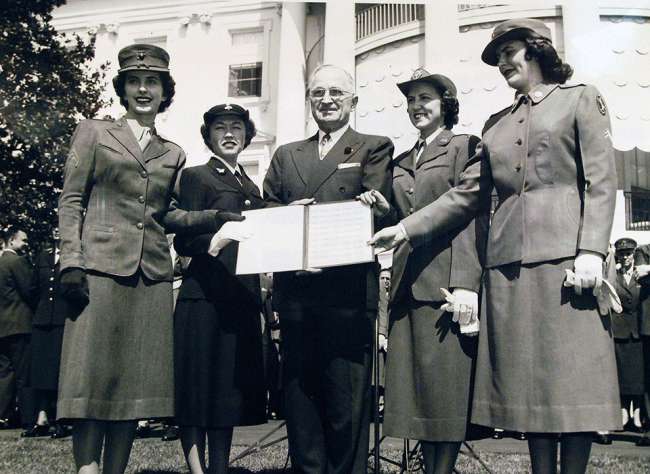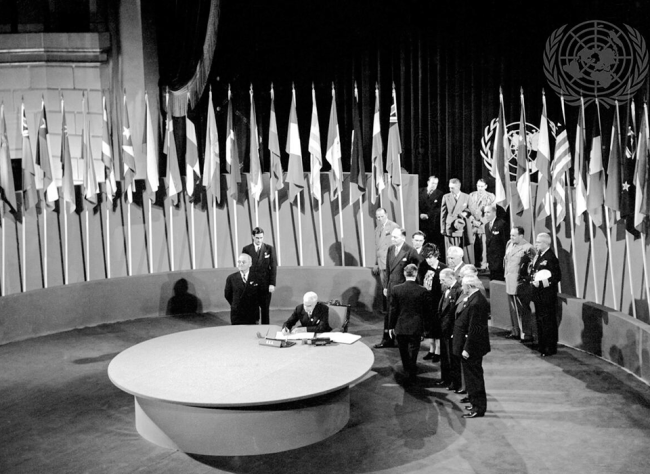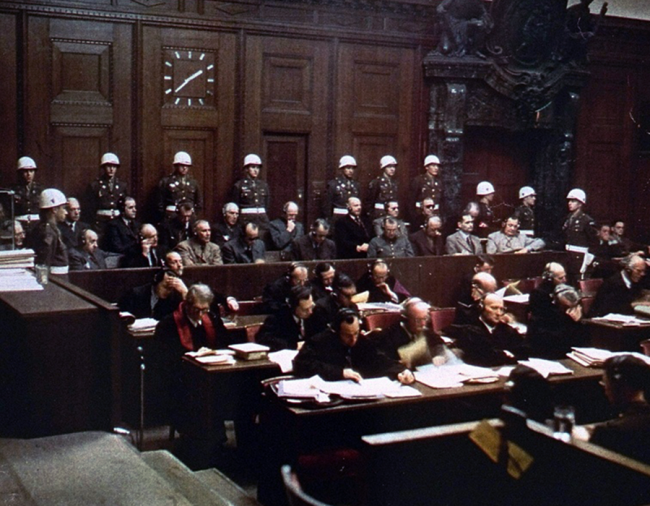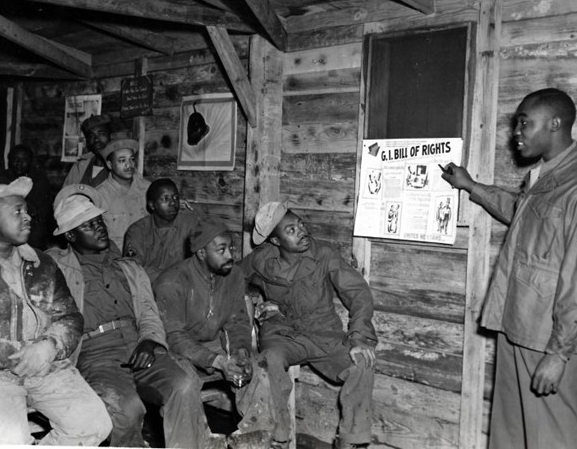Top Image: A souvenir photo of Arthur and Estelle taken in 1948, while they were living at the Cal Sea Food Trailer Camp in Harbor City. Image courtesy of the Estelle Ishigo Collection, Heart Mountain Wyoming Foundation.
In the fall of 1945, this question hung on the lips of most everyone inside the Heart Mountain camp in Northwest Wyoming—"Where are you going?" Three years before, the United States government forcibly removed all the Japanese Americans living on the West Coast—more than 110,000 people—and sent them to hastily built installations like this one. Two-thirds of the people incarcerated here were American citizens. Over half of them were children.
In the wake of Pearl Harbor, rumors and lies spread quickly throughout the nation that Japanese Americans were agents of the Imperial Japanese Army. Every person of Japanese ancestry, even those born in the United States, was viewed as a potential spy and saboteur. There was no evidence to support this conclusion, but the men in charge had already made up their minds. “The very fact that no sabotage has taken place to date,” said General John C. Dewitt, who headed up the Western Defense Command, “is a disturbing and confirming indication that such action will be taken.”
By the next summer, most of the Japanese Americans in the United States were living in cheap barracks, watched by armed guards, behind rows of barbed wire. That’s how things remained until December 1944, when the Supreme Court ruled in Ex parte Endo that loyal citizens could not be detained indefinitely. The War Department begrudgingly announced that Japanese Americans could return home.
The civilian agency that ran the camps, the War Relocation Authority (WRA), hoped to close Heart Mountain by February 1945. That proved to be impossible. The government had made no provision for preserving the property of Japanese Americans while they were incarcerated. Most had sold their homes, businesses, and farms at a loss before they left, not knowing what else to do. Others who tried to hang on to their real estate later found it had been destroyed by vandals or overrun by squatters. Returning home for Japanese Americans meant starting their lives over from scratch. The WRA, flooded with pleas for more time, agreed to keep the camp open until November.
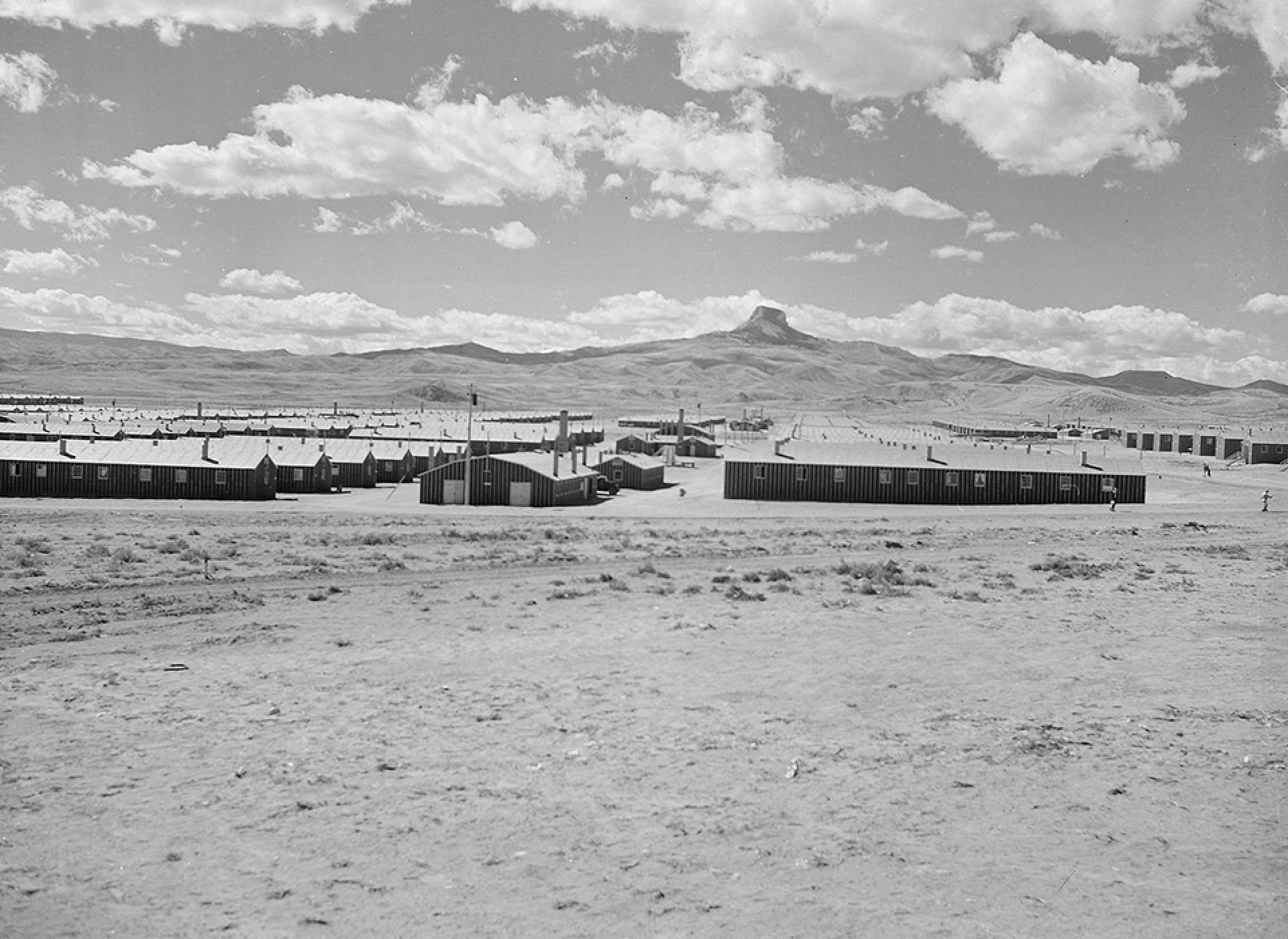
Looking west over the Heart Mountain incarceration camp. Image courtesy of the National Archives and Records Administration.
“Where are you going?”
Shig Yabu remembers his mother, Hana Okada, asking this question of her friends Arthur and Estelle Ishigo. The camp, which initially had a population of 10,767, had dwindled down to less than 5,000 people by that time, as incarcerees gradually found jobs and housing on the outside. Estelle Ishigo defiantly declared she and Arthur were not going anywhere; that rather than move again at the government’s whim, they would die at Heart Mountain.
Heart Mountain
Estelle had always stood out among the residents of the camp. A tall white woman with platinum blonde hair, she could easily be spotted around her home in Block 14, sketching scenes of daily life inside Heart Mountain. “Someone has to keep a record,” she’d always say.
When the government came for Arthur in 1942, Estelle refused to leave his side. She was allowed to accompany him to Wyoming, with the understanding that she would be treated no differently than her husband or any of the other Japanese American incarcerees. The Ishigos were one of less than a dozen mixed race families at Heart Mountain.
When he met Estelle, Arthur Ishigo was working as a sometime actor, sometime animal wrangler, sometime chauffeur, and sometime janitor at Paramount Studios. Estelle was studying at Otis Art Institute, where she had fallen in with a group of rebellious young Asian Americans who called themselves the “Art Students League of Los Angeles” and held court at the Dragon’s Den restaurant in Chinatown. According to Estelle, she and Arthur fell in love at first sight, and were inseparable from then on. Anti-miscegenation laws prevented them from marrying in California, so they eloped to Tijuana in 1928.
In the first weeks after the United States entered the war, Paramount fired its entire Japanese American staff. Estelle lost her waitressing and teaching jobs because she had a Japanese last name. Heart Mountain was, ironically, the safest and most accepting community they had ever lived in. Their reservations about leaving were almost understandable.
In her heart, Estelle knew she and Arthur could not stay in Wyoming. Even as she told Hana she’d die before she left, Estelle was writing friends settled back in Los Angelesto ask about the situation. Jobs were plentiful, she was told, although most returning Japanese Americans were taking low-wage domestic or gardening positions they would never have accepted before the war. “Housing is very acute here,” wrote one friend, from the hotel they were living in. “Acute” may have been an understatement. America’s wartime migration to the cities, combined with the sudden influx of returning veterans, had created an unprecedented housing crisis.
Though friends sent optimistic letters and promises of help, Arthur and Estelle were not able to secure a place to live before they left Heart Mountain in November 1945. Over 2,000 Japanese American incarcerees found themselves in similar circumstances. Worst affected were the disabled and elderly, those with limited means, and large families who needed more space than a hotel room could provide.
Unwilling to yet again extend the closure date for the camps, the WRA partnered with the Federal Public Housing Authority (FPHA) to convert former military encampments around Los Angeles into emergency housing. When the existing barracks at these camps proved insufficient for the number of desperate Japanese Americans, the government brought in trailers, some of which—according to Estelle—had first been used to house workers constructing the Hoover Dam in 1931.
Winona
Arthur and Estelle landed first at the Winona Trailer Camp in Burbank. Not long after they arrived, Estelle wrote a friend on the staff back at Heart Mountain. “Things are pretty bad here,” she confessed. “There is no place to live except FPHA and we are placed about 1.5 hours from town and 25 cents fare each way with more fare after reaching town to look for jobs which are scattered miles apart. Then one has to eat again or go hungry.”
The living conditions at Winona reminded Estelle of the worst parts of life at Heart Mountain. The barracks were riddled with “holes in roofs and floors.” The trailers almost all had busted fixtures, broken windows, and doors that refused to lock. Electricity was unreliable, and the communal toilets weren’t even connected to the sewer system. In place of the military guards, Estelle wrote that “night watchmen prowled the camp and ‘hoped there would be no trouble.’”
To live in such a place, the Ishigos had to pay a $10 deposit, $15 for rent each month, and $1.05 for three meals each day in the camp mess hall. Estelle noted that the families with many children couldn’t pay the mess hall fees, and instead cooked “all their meals on a hot plate.”
Faced with criticism from both residents and local health authorities, the WRA planned to close the Winona camp on March 1, 1946. The agency’s director reasoned that by then, they could surely find all the displaced Japanese Americans permanent housing. On February 28, Winona Trailer Camp still had 545 individuals living in it. The WRA was once again forced to revise its optimistic outlook. The agency closed Winona, with the plan to upgrade it into a long-term emergency housing facility.
Lomita
The closure forced the Ishigos to move yet again. They were sent to another trailer camp, located at the Lomita Flight Strip in Torrance. The Lomita Camp, the Ishigos were told when they first arrived, was already slated to be closed on May 1. The government was winding down the work of the WRA, and hoped to dissolve the agency altogether by summer. Estelle asked WRA officials, social workers, and even maintenance crews what would become of them next. Would they be allowed to return to the remodeled camp at Winona? “Keeping secrets won the war,” one official barked at her, and walked away.
The Ishigos, like so many others, were trapped in an endless cycle. Their fates were entangled in an incomprehensible web of state and federal agencies. Their trailers were located too far from the city to find reliable work. The meager earnings they could scrape together were barely enough for rent and food.
Estelle drew a portrait of Arthur, his beard long, standing in front of the camp fence. The city of Los Angeles rose up behind him, close but unreachable. Below the sketch, she scrawled a dubious question: “We are Americans, again?”
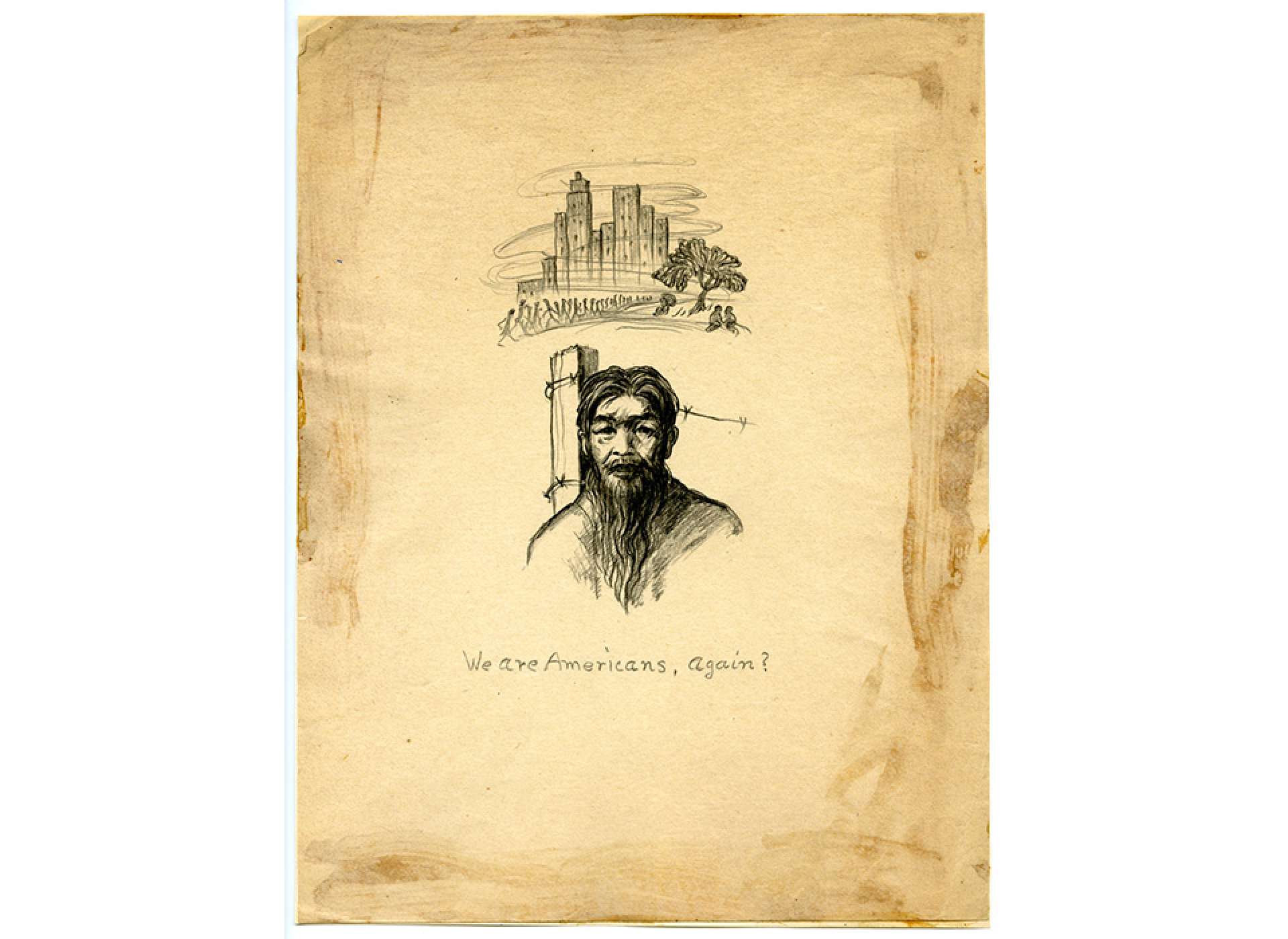
A return to life before the war was tantalizingly out of reach for Arthur and Estelle Ishigo. Image courtesy of the Estelle Ishigo Collection, Heart Mountain Wyoming Foundation.
One morning in May, Estelle came back from the laundry room to find workers cutting the electrical line to her trailer and hitching it to a truck. All the trailers, she learned, had been sold to the Cal Sea Food fish cannery in Harbor City, where they would become part of a labor camp. It was only by luck that Estelle had time to gather up her and Arthur’s possessions before the trailer was hauled away. The Ishigos moved into one of the old barracks buildings.
The next night, the camp’s electricity and water were cut off. In the morning, officials explained that the WRA was now closed, and that the camp’s residents were now the responsibility of the state’s welfare department. The shutoff, Estelle learned, “was to let us know that the camp was closing and we would have to accept any arrangement made for our housing and employment.”
Cal Sea Food had also returned, with offers for the Japanese Americans to move with the trailers to Harbor City. In exchange for pledging to work in the cannery, they would be allowed to live at the new labor camp. Thirty-six families signed up for the arrangement, though some grumbled it was akin to slavery.
Harbor City
Like all Japanese Americans in the trailer camps, Arthur Estelle had now suffered under the misguided benevolence, smug paternalism, and bureaucratic red tape of too many government welfare programs to count. And yet, the privately owned camp at Harbor City was somehow worse. “Trailers leaked in the winter rains,” Estelle remembered, “beds became moldy, the ground a muddy swamp. Water stood in deep pools with green slime.”
The racial hatred of the past five years had cut Arthur deeply, likely deeper than even Estelle could understand. Still, he had soldiered on gamely, believing that anger solved nothing and positivity was the secret to overcoming life’s challenges. It was Harbor City that finally broke him. “He was different now than he used to be…” Estelle wrote. “He never recovered.”
The cannery camp was a muddy one-acre tract, completely enclosed in barbed wire, with 47 trailers packed end to end. The 135 people who lived there shared six sinks, 10 toilets, and six showers. Visitors were afraid to come to the camp, with the occasional exception of “social workers and religious friends.”
Arthur and Estelle found an old washtub and placed it in front of their trailer. They dragged driftwood up from the beach to serve as makeshift benches. On pleasant evenings, they would fill the tub with coals and sit by the fire. Children from around the camp gathered with them there. Most of these children had no recollection of life outside a camp. Their first memories were of Heart Mountain. They had only known the constant shuffle from one institution to another. At least here at Harbor City, completely forgotten, there was no imminent threat of eviction. No one was forced to leave the camp until the county finally condemned it in 1948.
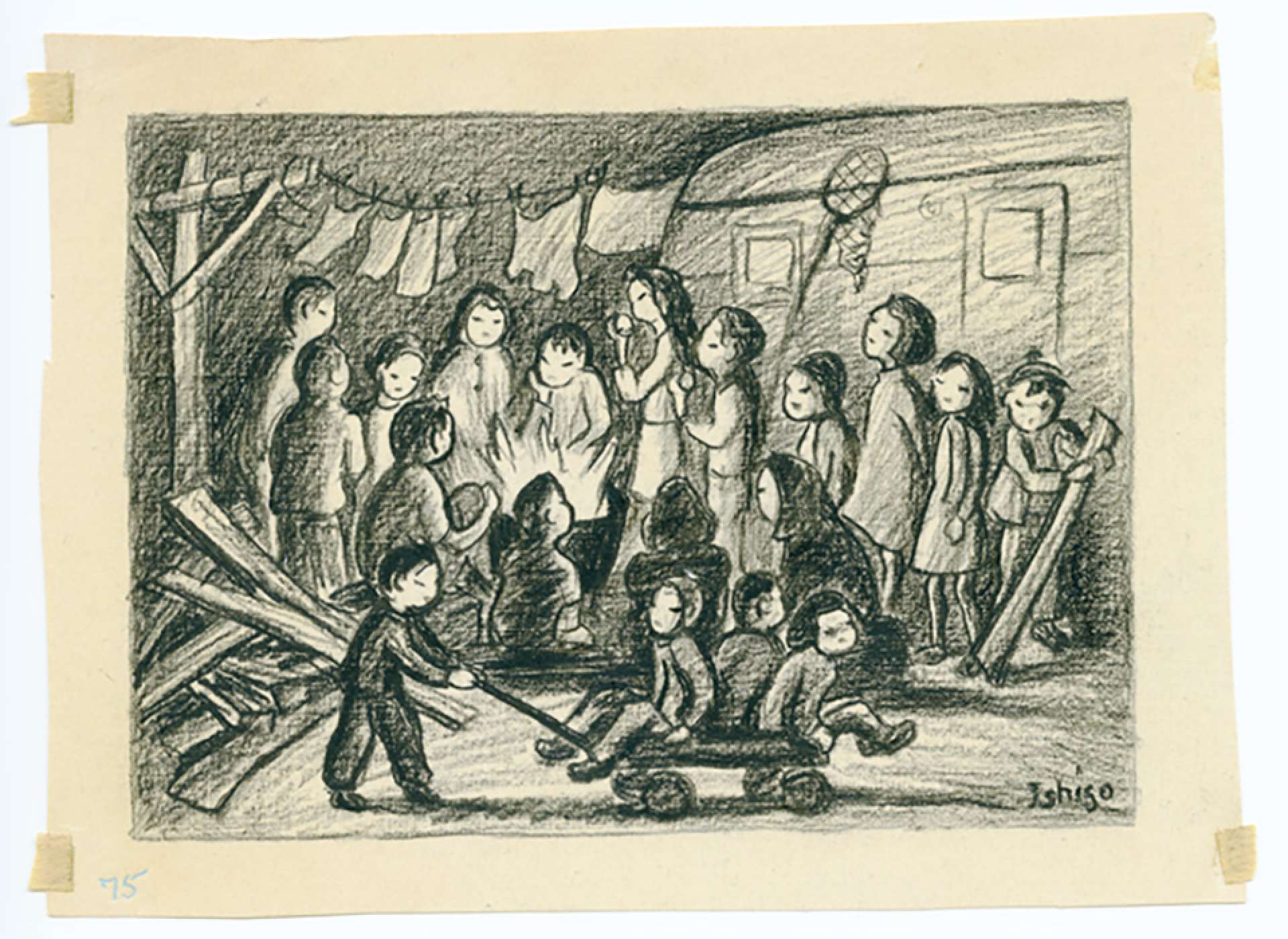
Children gather around a fire in an old washtub in front of Arthur and Estelle’s trailer in Cal Sea Food Labor Camp in Harbor City. Image courtesy of the Estelle Ishigo Collection, Heart Mountain Wyoming Foundation.
Living in the shadow of the cannery, Estelle continued the work that she began at Heart Mountain, documenting everyday life through her sketches and paintings. She had once dreamed of returning home, exhibiting her artwork, and exposing the government’s treatment of its loyal Japanese Americans citizens during the war. Now, she realized that even though the war was over, the story likely never would be. The scars of this injustice would last lifetimes, even generations. Unable to stop it, all she could do was record it. Someone had to keep a record.
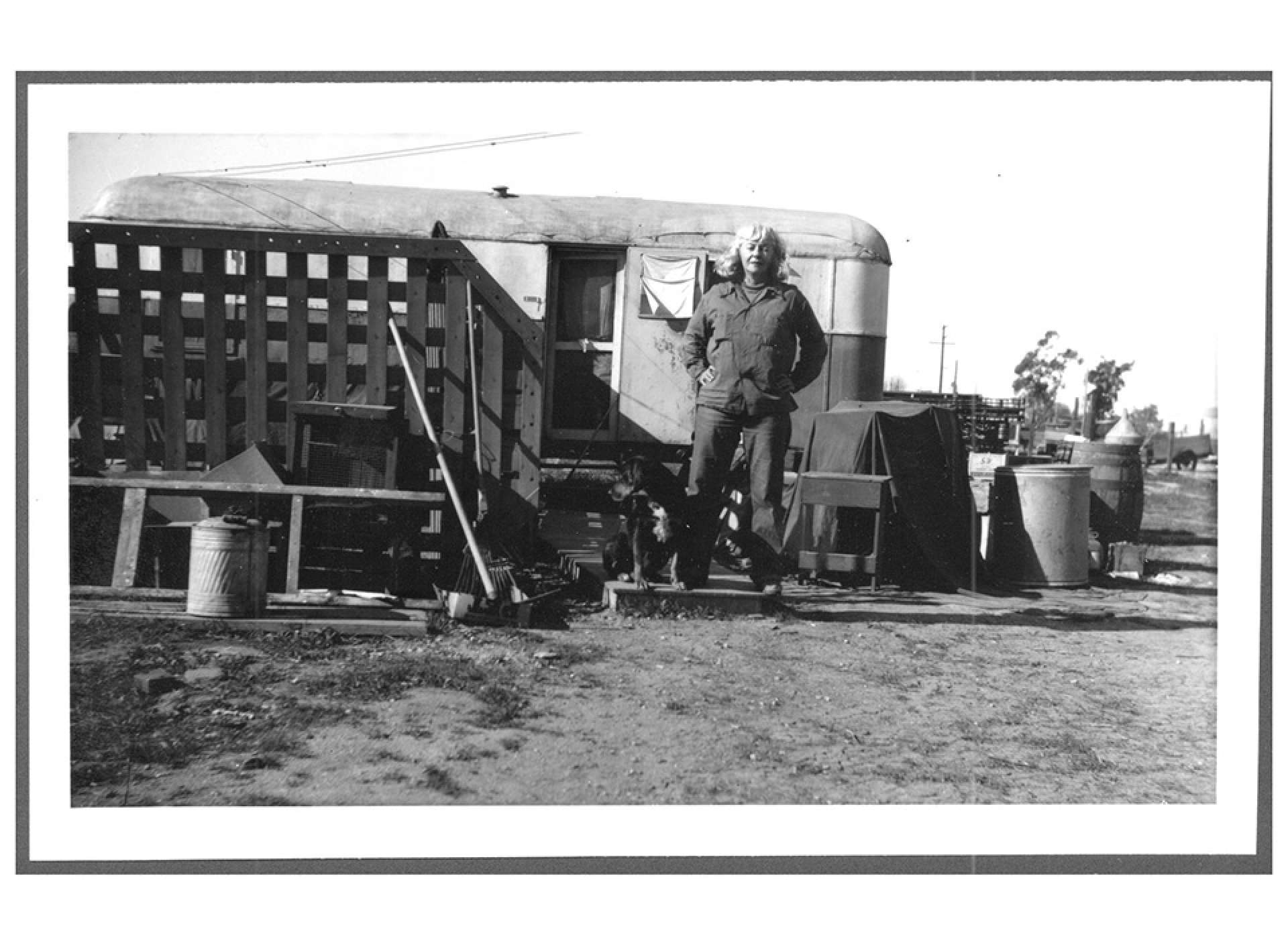
Estelle Ishigo stands in front of the trailer she shared with Arthur at the Cal Sea Food Labor Camp in Harbor City. Image courtesy of the Estelle Ishigo Collection, Heart Mountain Wyoming Foundation.
Meet the Author
Dakota Russell is Executive Director of the Heart Mountain Wyoming Federation.
This article is part of a series commemorating the 75th anniversary of the end of World War II made possible by the Department of Defense.
Cite this article:
MLA Citation:
APA Citation:
Chicago Style Citation:
